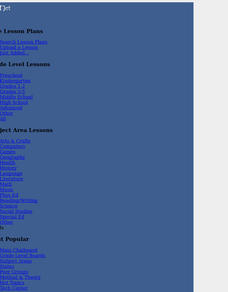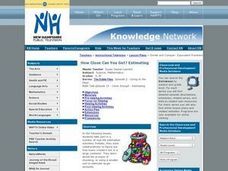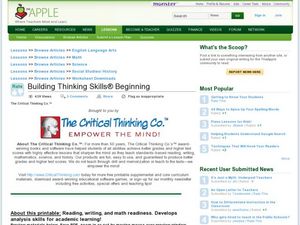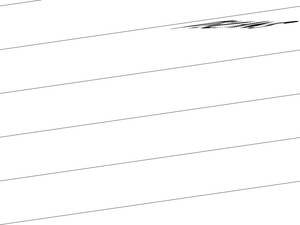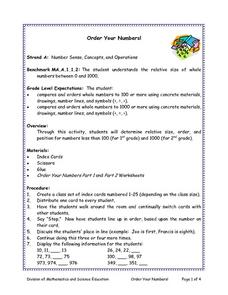Curated OER
Sunrise, Sunset: Quickly Go the Days
Students explore the concept of daylight. In this daylight instructional activity, students compare the amount of daylight on a particular day in Anchorage compared with daylight where they live. Students color maps of the US according...
Curated OER
Lace Pictures
Students create Valentine's Day gifts. In this visual arts lesson, students create a Valentine's Day project using paper doilies pasted onto construction paper. Students frame their art with brown construction paper and give their...
Curated OER
Weather
Students participate in a variety of mini-lessons including experiments, literature readings, physical education components, music, data gathering and recording and more to expose them to several themes of weather; i.e. water cycle,...
Curated OER
Powers of Ten
Young scholars make paper ten strips using graph paper. They add them together to depict the powers of ten.
Curated OER
Fossils
Young scholars act as paleontologists to discover who a mystery guest to the classroom was. They do not know the identity of the guest but infer the identity from items left behind in the classroom. They make inferences from dinosaur...
Curated OER
Predicting Temperature: An Internet/Excel Learning Experience
Third graders use the Internet (www.weather.com) to find the high temperature for our locale and the high temperature for another city around the world. They keep track of the temperature in these two locations for 10 days.
Curated OER
Where Does the Green Go?
Students investigate why green leaves change colors in the fall. They press leaves and write a poem, create a chlorophyll leaf print, take a nature walk, and create a leaf shape poster.
Curated OER
How Big Are Earth, Sun, and Moon?
Third graders draw what they believe is in space on a dry erase board. In groups, they are given a beaker half filled with water and they add a teaspoon of oil, observing the different layers that form. To end the lesson, they identify...
Curated OER
How Close Can You Get? Estimating
Students work collaboratively to determine how many crackers are in a large container. They then view a video to see how often people use estimation in their jobs, and another video to watch students work on figuring out appropriate...
Curated OER
Learning to Make Bar Graphs
Students construct bar graphs using the results from various experiments. In this graphing lesson, students review data from a previous experiment and demonstrate how to construct a bar graph. Students use a checklist to ensure...
Curated OER
Thinking Skills: Connecting shapes
In this thinking skills worksheet, students draw a line connecting each blue figure without touching any other color. Students connect 4 figures.
Curated OER
What Type of Snow Makes a Good Snowman
Students attempt to build a snowman. For this comparison lesson, students divide into groups, are given different types of snow (dry and wet) and try to make a snowman. Students discuss and record the characteristics of the snow and...
Curated OER
Bringing Up Birdy
Students explore biology by creating diagrams of animal life cycles. In this baby bird activity, students view video clips of birds being born from incubation to flying on their own. Students utilize the Internet to research birds and...
Curated OER
Puerto Rican Parrot Paradise
Young scholars investigate the environment of the Puerto Rican Parrot. They visualize the ecosystem with and without information. They conduct research to find information and participate in classroom discussion to demonstrate...
Curated OER
Build a Weather Vane
Learners construct a weather vane using their knowledge of some geometric shapes. In this weather lesson, students work in pairs to create a weather vane in order to measure wind direction. Learners follow precise...
Curated OER
Impacts to the Open Ocean
Young scholars investigate how human beings impact ocean ecosystems. In this ocean ecosystem lesson, students explore how marine debris affects marine life. Internet resources are provided.
Curated OER
Olympic Metrics
Students study metric measurements related to Winter Olympic events are converted to their U.S. equivalents. (Younger students use an online metric converter; older students use a formula to calculate the measurements.) Work sheets are...
Curated OER
Everybody Needs a Rock
Students, after making quantitative and qualitative observations of their rocks, construct a Venn diagram or dichotomous key to classify their rocks.
Curated OER
OTC Medications
Students sort medications by likeness and use. They compare and contrast using a Venn Diagram, and find the differences and commonalities of over the counter and Rx medications.
Curated OER
The Function Box
Students explore arithmetic and numerical patterns. After observing a teacher created function box, students describe a pattern and predict what will "come out" of the function box. They explore patterns such as geometric shapes,...
Curated OER
Pecan Lessons
Young scholars complete lessons on the computer related to pecans. Students complete assignments such as typing descriptions of pecan categories, using email to find out information, researching the internet about production regions, and...
Curated OER
Geometry and Shapes in the X-36
Students describe, draw, and classify shapes. They use the internet to research the X-36 aircraft. Students identify the geometric shapes in the aircraft. They calculate the number of sides in an x-36.
Curated OER
Order Your Numbers
Young scholars examine the order of whole numbers that range from 0 to 1,000. They compare and contrast the quantities of different numbers using the number line, objects, and symbols of comparison. Students also work as a class with...
Curated OER
Calculating Buttons
Students, after reading "The Button Box" by Margarette S. Reid, analyze real-world data by surveying a sample space. They predict the generalization onto a larger population utilizing calculators and computers. Students total categories,...


